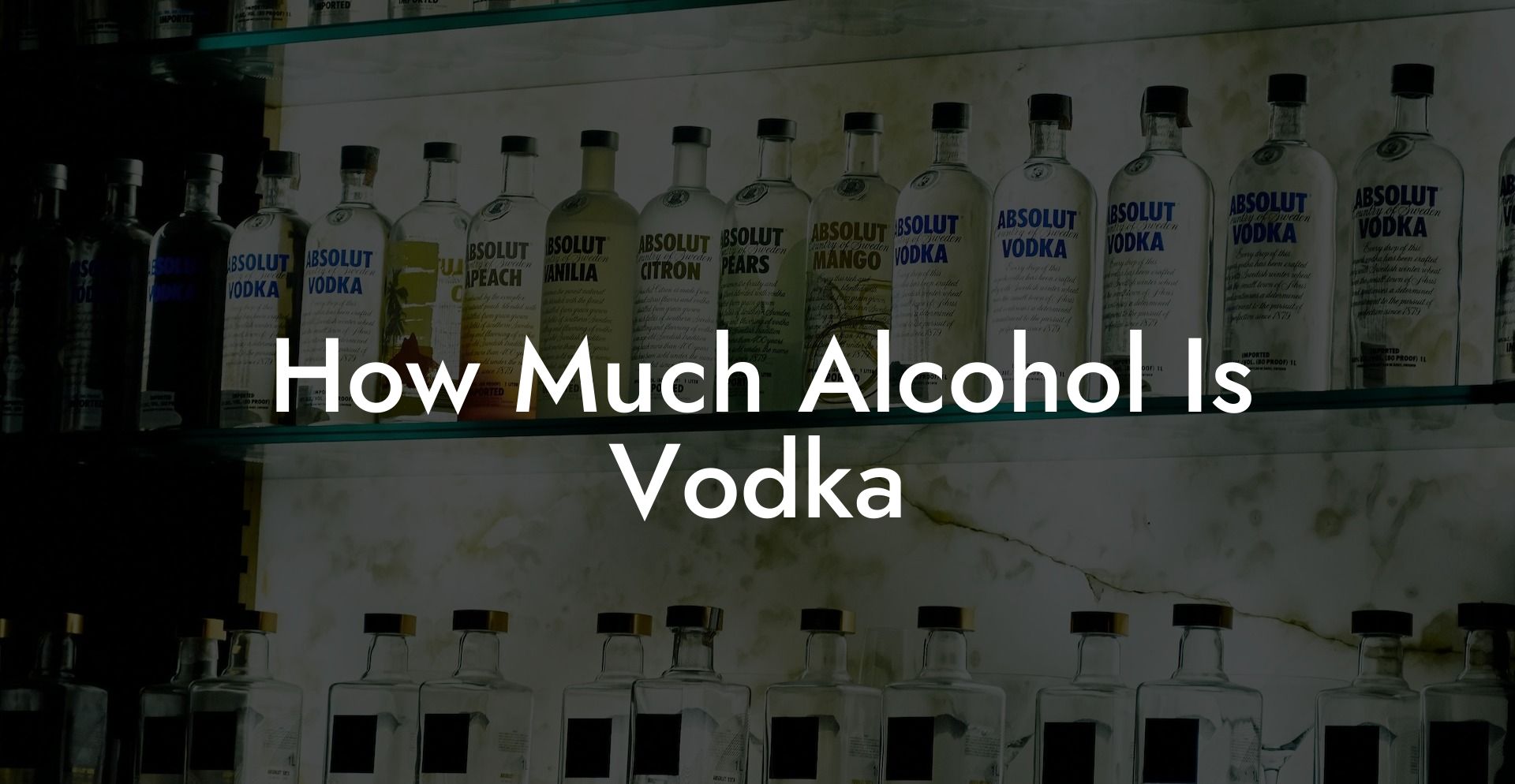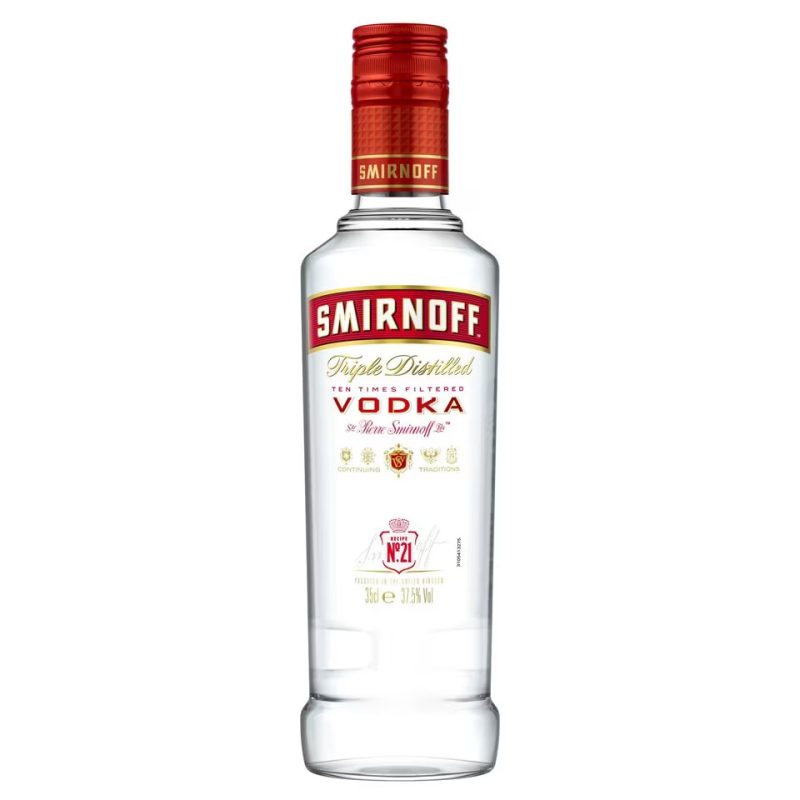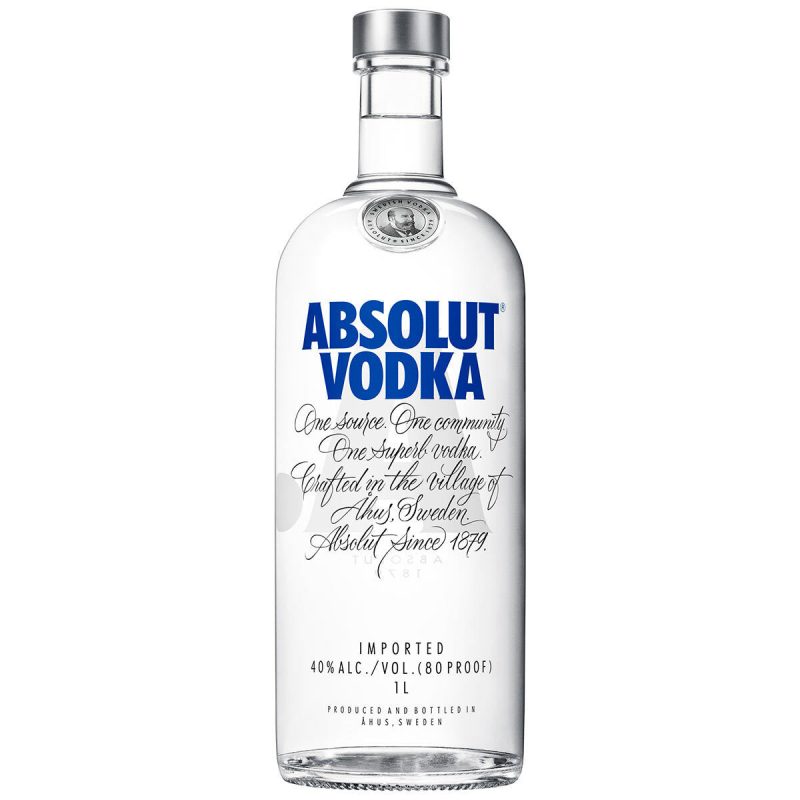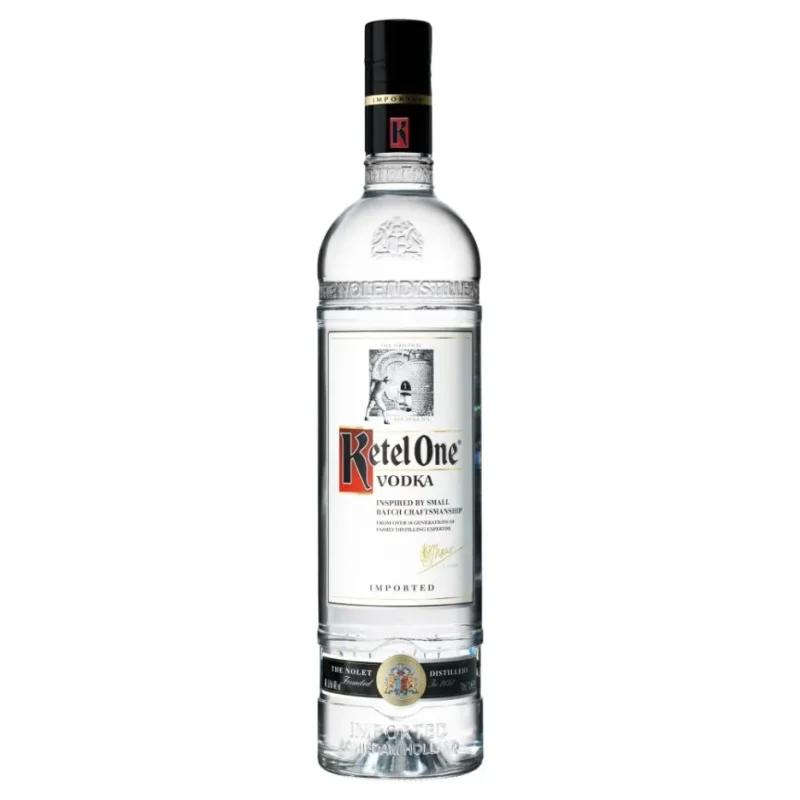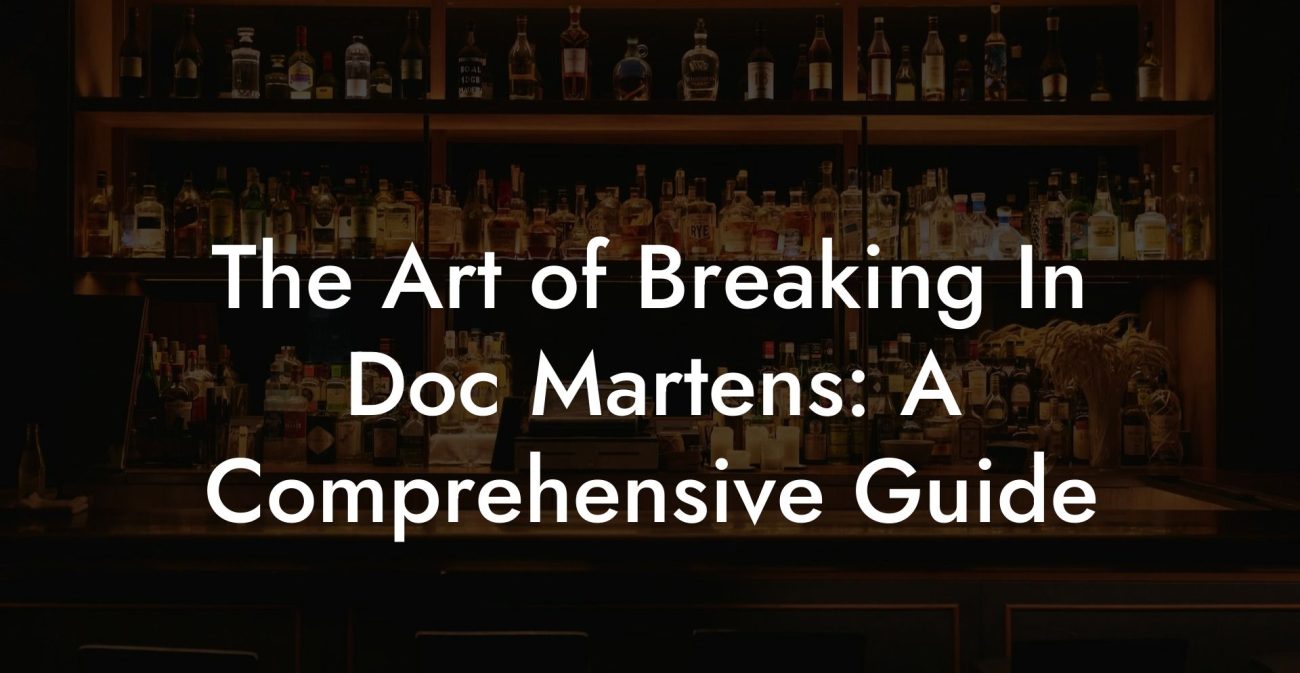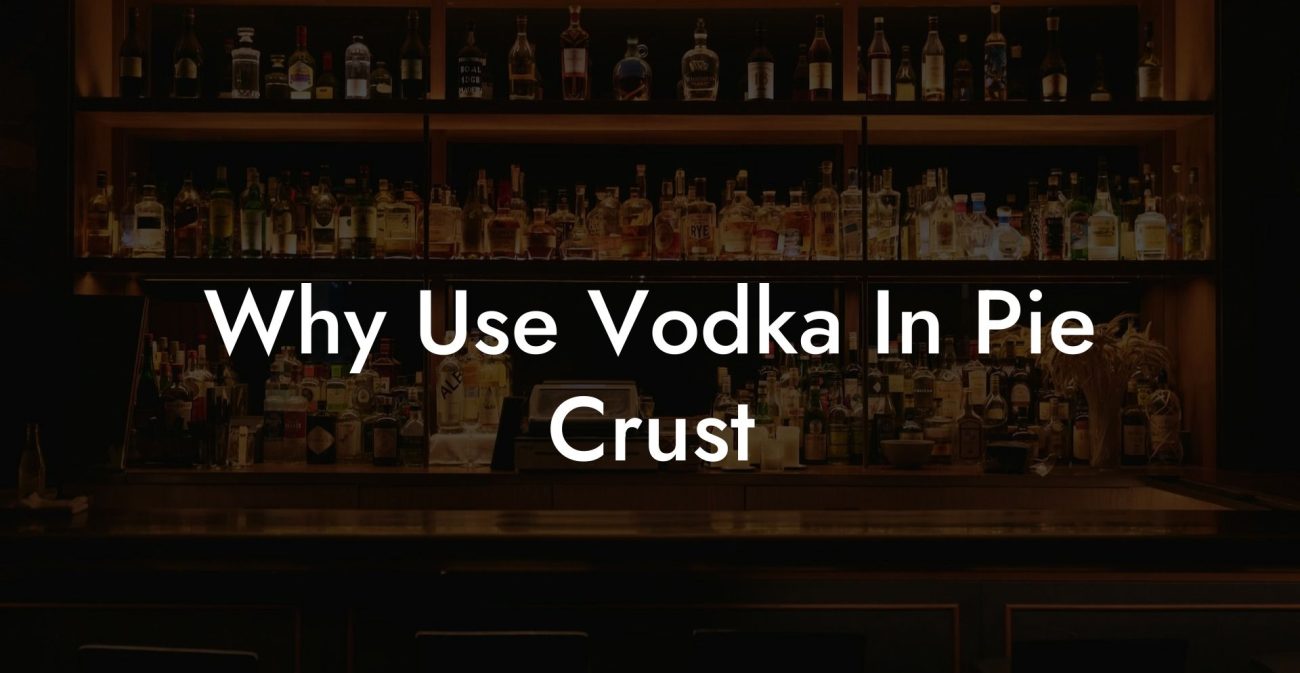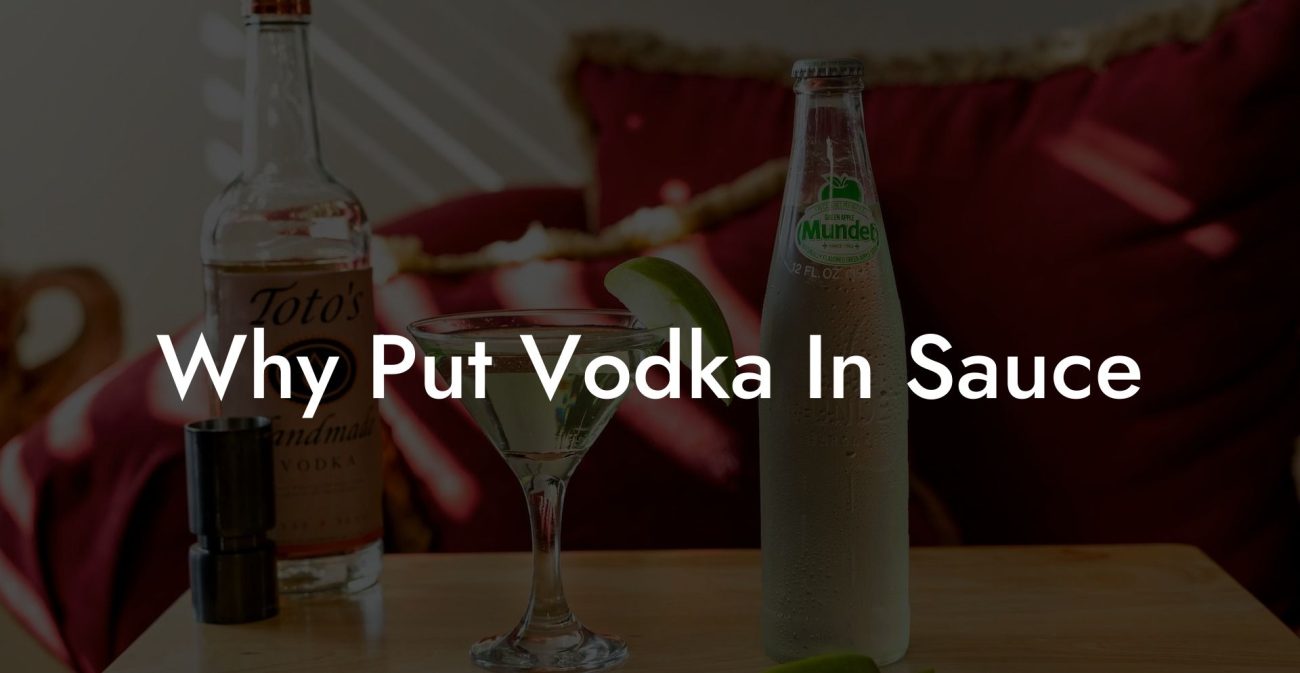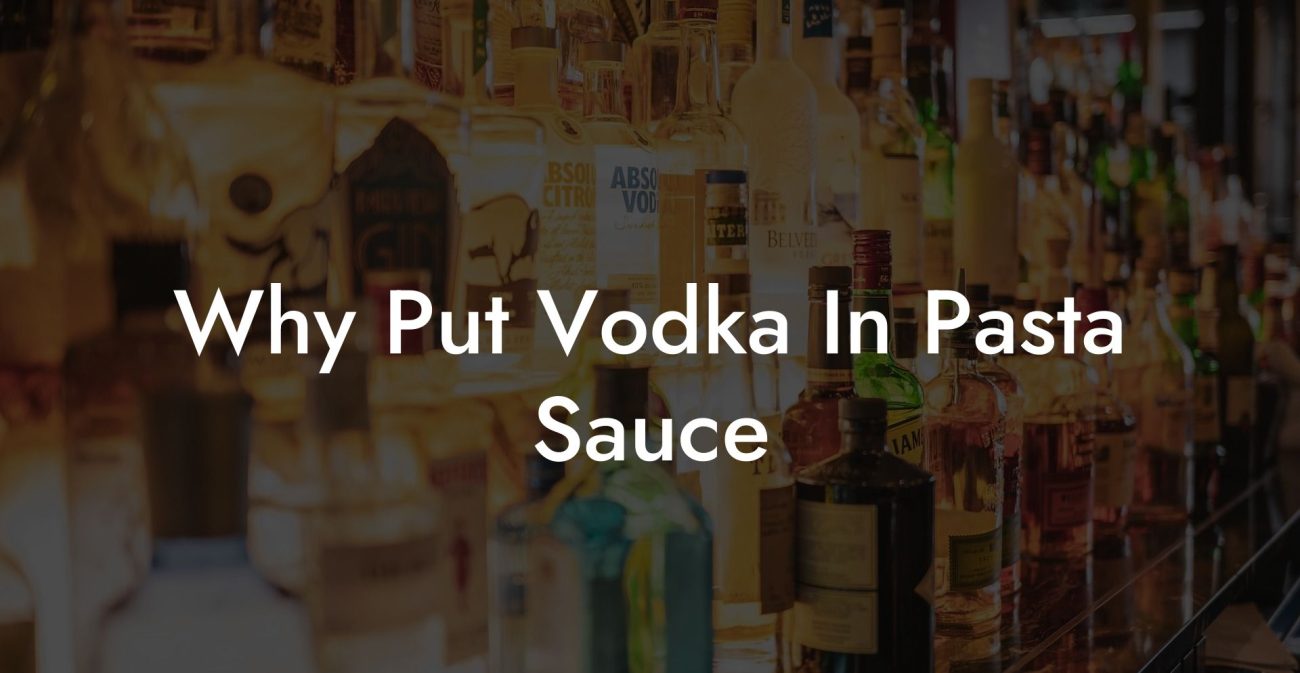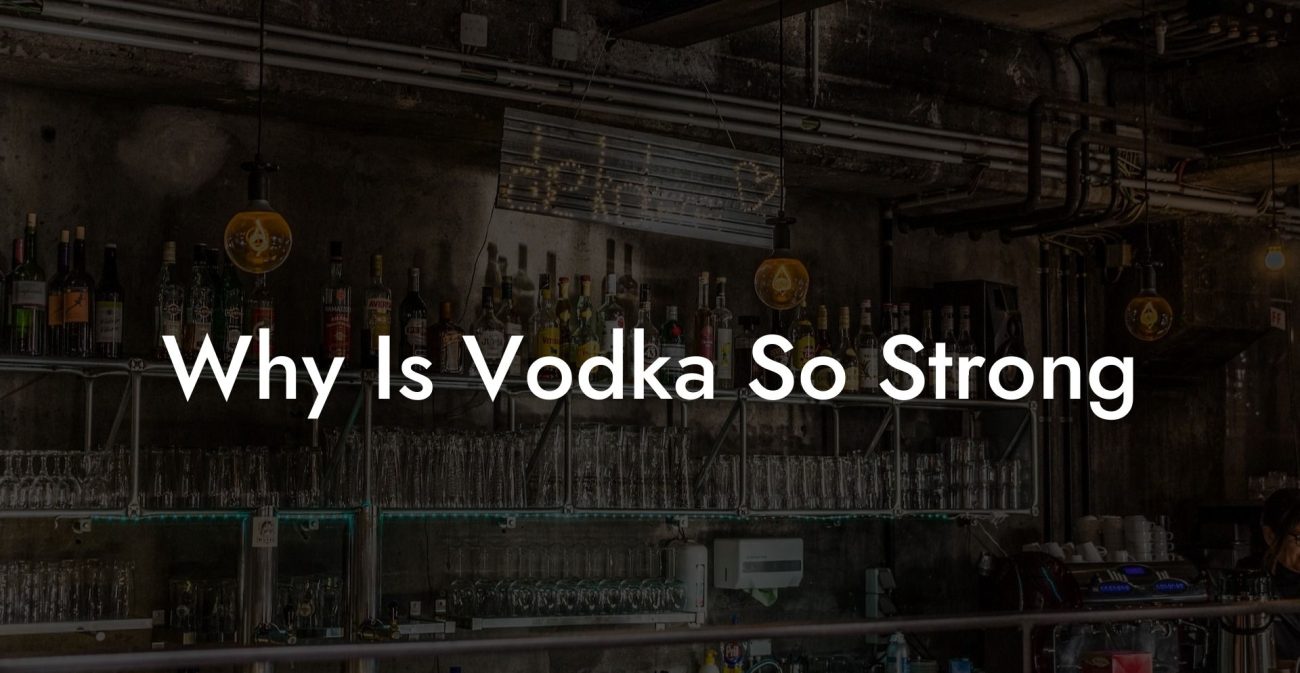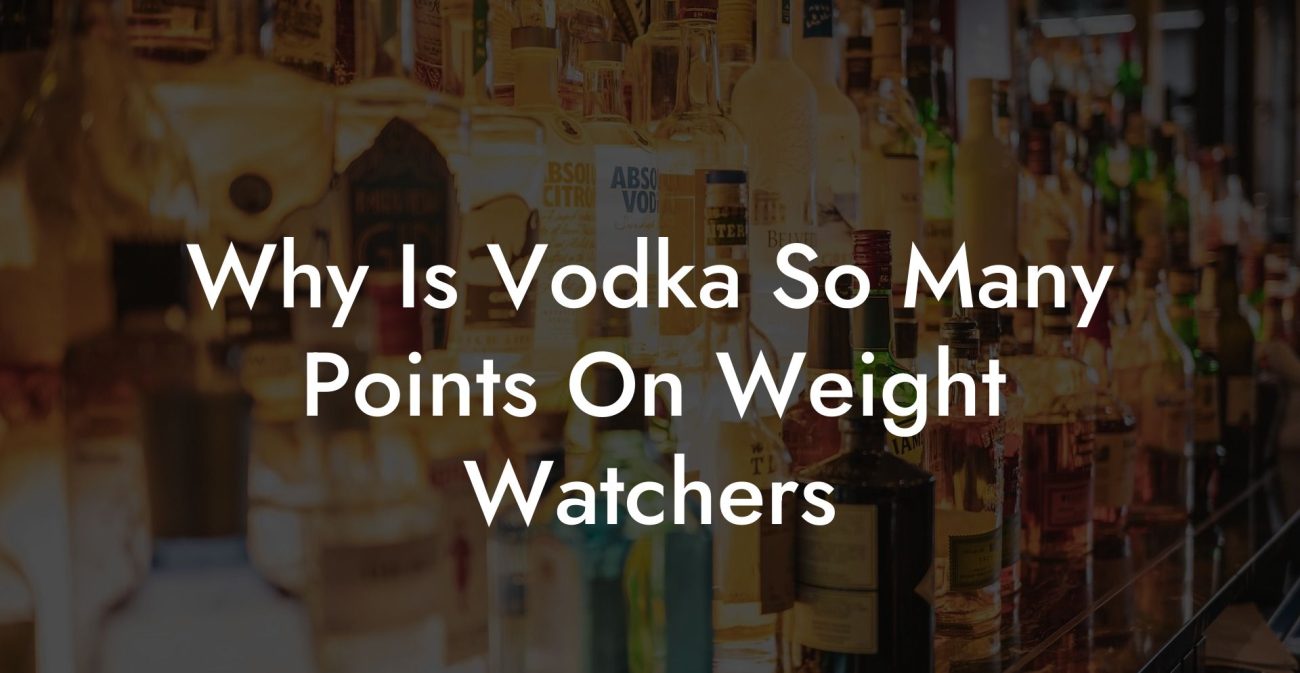Ever wondered if your favorite vodka cocktail is more than just a buzz-worthy elixir? Get ready to dive deep into the spirited world of vodka where we answer the burning question: “How Much Alcohol Is Vodka?” From milky white bottles that pack a serious punch to the artisanal flavors that have taken over your Instagram feed, we're serving you a comprehensive, laugh-out-loud, and data-packed guide that even your most discerning millennial or Gen Z friend will appreciate. Grab your favorite drink (responsibly, of course), sit back, and let's unravel the mysteries behind the spirit that’s been at the center of every epic party and heart-to-heart conversation.
How Much Alcohol Is Vodka Table of Contents
The Foundations of Vodka’s Alcohol Content
Measuring Alcohol Content: Understanding ABV and Proof
Beyond the Basics: How Production Methods Influence Alcohol Strength
Popular Vodka Brands and Their Alcohol Percentages
Vodka Cocktails: Mixing It Up with Precision
Responsible Drinking: Tips for Knowing Your Limits
Exploring International Vodka: A Global Perspective
The Science Behind Vodka: What’s in Your Glass?
Resources and Community Support: Your Next Steps
Vodka in Pop Culture: From Movies to Memes
The Future of Vodka: Trends on the Horizon
Global Vodka Festivals and Events: Where to Celebrate
Integrating Vodka Knowledge Into Your Daily Life
Culture, Creativity, and Vodka: A Match Made in Heaven
Integrative and Holistic Approaches FAQs: Your Vodka Questions Answered
Your Journey Through Vodka: Embrace the Spirit with Knowledge and Fun
Looking For The Best Vodka? You'll Love These Vodka Guides...
What Exactly Is Vodka?
Vodka, often dubbed the “neutral spirit,” is the chameleon of the alcohol world. Born in Eastern Europe but celebrated globally, vodka is typically distilled from fermented grains, potatoes, or even fruits. Its iconic clarity and clean taste make it the perfect base for cocktails, yet beneath its seemingly simple surface lies a complex history, a nuanced production process, and, in our case, a precise level of alcohol content that makes it both potent and versatile.
Its unflavored, neutral characteristics allow it to mix seamlessly with almost any ingredient, making it the darling of mixologists everywhere. Whether you’re swirling it into a classic martini or enjoying it neat (if you're feeling fancy), knowing how much alcohol is in vodka is key to enjoying it responsibly while still keeping the vibe fun and uninhibited.
From its humble beginnings in the 14th century to its status as the life of the party today, vodka is as culturally diverse as the cocktails it inspires. Let’s dive into the details and discover what makes vodka the spirit of choice for so many.
The Foundations of Vodka’s Alcohol Content
When it comes to answering the question “How much alcohol is vodka?”, the short answer is: most vodkas hover around 40% alcohol by volume (ABV). But keep your party hats on, because there's a lot more to this number than meets the eye.
Traditionally, most vodkas are distilled to a high proof and then diluted with water to create a balanced spirit. Think of this process like brewing your favorite cup of coffee — you start with something extra strong and then mix in water to get just the right taste. For vodka, that dilution step is crucial because it’s what gives you the smooth, clean finish without completely nullifying its potency.
Best Budget Vodkas Ranked
What does 40% ABV really mean? Simply put, in every 100 milliliters of vodka, 40 milliliters are pure alcohol. This ratio can impact everything from the flavor profile to the body’s absorption rate, which means the same shot that powers a wild night out might also be counted as one standard drink in most bars worldwide.
But wait—there’s a twist! Some artisanal or craft vodkas may tweak that percentage slightly, offering versions with higher or lower alcohol content. While these are the exception rather than the rule, it’s worth keeping an eye on the label if you’re an enthusiast looking to explore beyond the norm.
Measuring Alcohol Content: Understanding ABV and Proof
Let’s break down the two most common ways vodka’s strength is measured: ABV (Alcohol By Volume) and Proof. If you’ve ever found yourself scratching your head in the liquor aisle, this section is for you.
The ABV Breakdown
As mentioned earlier, ABV is the percentage of pure alcohol in a beverage. Most vodkas proudly display a 40% ABV, though you might occasionally stumble upon a 38% or 42% variant during your spirited adventures. This metric gives you a direct idea of how much alcohol you’re sipping with every shot.
Why is ABV important? It’s simple. Knowing the ABV helps you gauge how quickly you might feel the effects of your drink. For someone who’s juggling a busy day or just wants to pace themselves on a night out, recognizing these numbers can be a game-changer.
The Proof System
The “Proof” system is a bit of an old-school measurement mainly used in the United States. The proof is calculated as exactly twice the ABV number. So, if you’re enjoying a 40% ABV vodka, you’re technically dealing with an 80-proof spirit. It’s not rocket science — but it does add a fun layer of trivia at cocktail parties.
More than just a number, these measurements tell part of the story behind every bottle and invite you to delve deeper: Why do some vodkas boast higher proof levels? How does that impact flavor and mixing potential? The answers lie in the careful balancing act performed by distillers.
Beyond the Basics: How Production Methods Influence Alcohol Strength
The way vodka is made isn’t just a nod to tradition — it actively influences its alcohol content, flavor profile, and overall character. Let’s take a peek behind the curtain and see how production choices shape the spirit we all know and love.
Distillation Process
Vodka starts with fermentation, much like your favorite sourdough starter, but instead of feeding it with flour and water, producers use grains, potatoes, or even grapes. The fermented mash is then distilled, a process that essentially concentrates the alcohol by heating the liquid and collecting the vapor. The more runs through the still, the purer your vodka becomes — sometimes reaching the point of near perfection where impurities are barely detectable.
Each distillation pass can be seen as a filtering process, allowing distillers to adjust both the flavor and the strength of the final product. Think of it as a remix: the more times you mix the tracks (or in this case, the more you distill), the smoother and more refined the end result.
Dilution: The Final Frontier
After distillation, the concentrated alcohol is usually too potent to drink as-is. Enter the dilution phase, where high-quality water is added to bring the spirit down to the desired ABV level. This isn’t just water, though — many vodkas use mineral water or water from specific sources to add a unique twist to the final flavor.
The art of dilution is where science meets creativity. Too little water, and you risk an overly harsh taste; too much, and that bold character might dissipate. Achieving the perfect balance is both an art and a science, and it’s why some vodkas have earned the reputation of being exceptionally smooth.
Filtration Techniques
Some modern vodkas employ advanced filtration techniques using activated charcoal, quartz, or even precious metals. These processes are designed to remove impurities and may even subtly influence the perceived strength of the spirit. The result? A cleaner, crisper taste that not only highlights the vodka’s purity but also ensures a consistent alcohol content.
Whether you’re a casual drinker or a discerning connoisseur, understanding these production methods can add a new layer of appreciation to your next glass of vodka — and might even score you some extra cool points among your friends.
Popular Vodka Brands and Their Alcohol Percentages
Let’s talk brands! While the majority of vodkas stick to that 40% ABV golden rule, there’s a vibrant world of options out there, each with its unique twist on alcohol content and flavor. Whether you’re at a high-end bar or mixing cocktails at home, knowing your vodkas can be as crucial as knowing your dance moves.
Classic 40% ABV Powerhouses
For most of us, the go-to vodkas are the tried-and-true legends that youll see lined up on every liquor store shelf. Brands like Smirnoff, Absolut, and Grey Goose consistently offer vodkas with around 40% ABV. These bottles are dependable and deliver that smooth, balanced punch that makes them ideal for mixing in cocktails or enjoying straight (for those with a high tolerance!).
Their reputation isn’t just built on numbers; it’s about how they capture the essence of vodka without overshadowing the other ingredients in your drink. It’s a delicate dance of strength and subtlety.
High-Proof Variants
Looking for an extra kick? Some vodkas are crafted with higher proofs for those who like to feel like they've just taken a shot of liquid adrenaline. These variants, which can sometimes reach 50% ABV or even slightly higher, pack an intensified punch and are often used in cocktail recipes that require a bolder flavor profile.
The world of high-proof vodkas is a playground for mixologists who want to push boundaries. They provide a canvas for innovative cocktail creations and experimental flavors that transform even the simplest drink into a bold statement.
Flavored Vodkas and Their Unique Twists
Flavored vodkas are all the rage on social media and in party circles. From zesty citrus to sweet vanilla and even quirky options like cucumber or chili, flavored vodkas typically maintain that roughly 40% ABV metric. However, depending on the infusion process, some might have minor deviations in alcohol strength.
These vodkas are popular because they let you experiment without committing to a single taste. They’re great for both sipping neat and adding a creative twist to your cocktails. Just remember: even though they might come with a twist, the core strength remains in that 40% zone, ensuring consistency and reliability.
Vodka Cocktails: Mixing It Up with Precision
Vodka is the ultimate party starter because it blends seamlessly with nearly any ingredient. The backbone of countless classic and modern cocktails, its measured alcohol content allows mixologists to concoct drinks that are both potent and balanced.
Classic Cocktails that Stand the Test of Time
Ever heard of the Vodka Martini? It’s immortalized by James Bond and remains a favorite for its stylish simplicity. With a typical mix of 40% ABV vodka, dry vermouth, and a lemon twist or olive, the drink showcases the vodka’s spirit without overwhelming the palate.
Then there’s the Bloody Mary — a brunch staple that packs a punch, mixing the robust flavors of tomato, spices, and a standard 40% ABV vodka base. Whether you’re recovering from a long night out or just enjoying a lazy Sunday, these cocktails prove that the alcohol content is engineered just right to elevate your experience.
Innovative Concoctions for the Modern Palate
Millennials and Gen Z are leading the charge with creative twists on classic drinks. Think of low-calorie infusions, mocktail mash-ups that gradually ramp up to spirited cocktails, and even the trendier “hard seltzers” where vodka meets effervescence. Each recipe respects the inherent alcohol strength while offering a unique twist, whether it’s by layering flavors, adding unexpected ingredients, or exploring new textures.
The secret to these innovative recipes is balance. The consistent 40% ABV ensures that no matter how wild your creation, you’re always starting from a trusted baseline. So go ahead: experiment with your mixers, garnish extravagantly, and craft a cocktail that’s as bold as your personality.
Responsible Drinking: Tips for Knowing Your Limits
While vodka is undeniably fun and versatile, it’s important to remember that its very nature demands respect. Knowing how much alcohol is in your glass is the first step to making smart choices before your first dance-off or late-night snap session on social media.
With a standard 1.5-ounce shot of 40% ABV vodka equating to one standard drink, it’s easy to lose track during a night out with friends or a chill evening at home. A few tips for keeping it all in balance include:
- Measure Wisely: Avoid the “eyeballing it” method — invest in a jigger or a measuring cup to ensure proper serving sizes.
- Pace Yourself: Sipping slowly not only lets you savor the flavor but also helps your body better manage the alcohol.
- Hydrate: Alternating your cocktails with water can help keep you refreshed and extend the party.
- Know Your Limits: Whether you’re mixing cocktails or enjoying vodka neat, listen to your body and avoid overindulgence.
Remember, the best parties are the ones where you wake up happy and healthy, ready to scroll through your Insta feed and laugh about the good times.
Exploring International Vodka: A Global Perspective
Vodka is a global phenomenon, celebrated in many cultures with their own unique twists on this spirit. While the standard alcohol content tends to hover around 40% ABV, different regions offer subtle variations that can add new layers to your drinking experience.
Eastern European Roots
Originating in countries like Russia and Poland, vodka’s rich history is as deep as the snow in a Siberian winter. Traditional recipes have been passed down through generations, and while modern distillation techniques have standardized the 40% ABV benchmark, many enthusiasts still relish the heritage, savoring every sip as if it were a liquid piece of history.
Nordic Nuances
In Scandinavia, vodka production has taken on a modern twist. The use of clean, glacial water and advanced filtration methods has resulted in some of the smoothest spirits on the market. Even if the alcohol strength remains similar, the crisp and refreshing finish is designed to capture the essence of the northern lights and long winter nights.
Asian Artistry
While vodka isn’t traditionally associated with Asian cultures, experimental distilleries in countries like Japan and South Korea have embraced the spirit, infusing it with local fruits and botanicals. These innovative approaches sometimes result in slight deviations in alcohol content, offering curious drinkers a chance to taste something truly different.
Each region, with its unique production methods and cultural flair, adds to the rich tapestry of vodka’s history—a history that’s as diverse as the people who enjoy it.
The Science Behind Vodka: What’s in Your Glass?
Ever wondered what really goes on inside your bottle of vodka? Beyond the alcohol, vodka is essentially a blend of water, ethanol, and a few trace compounds that can influence everything from aroma to aftertaste.
Ethanol, the chemical name for the alcohol in your drink, is the star of the show. At 40% ABV, that means if you have a 100 ml serving of vodka, 40 ml of that is ethanol — the stuff that gets you dancing on tables (or at least makes you feel like you could). The rest is water, which helps round out the flavor and keep the spirit from being overly harsh.
There are also minor compounds like esters, aldehydes, and even tiny amounts of congener that lend a distinctive character to each brand. While most of these compounds are removed during distillation, a few might linger, contributing to the subtle differences between brands. It’s a fascinating interplay of science and art, where precise measurements meet centuries-old recipes.
So next time you take a sip, know that you’re not just enjoying a drink—you’re experiencing a carefully crafted symphony of chemistry, tradition, and innovation.
Resources and Community Support: Your Next Steps
Whether you’re a budding mixologist, a seasoned cocktail connoisseur, or simply someone curious about the nuances of vodka, there are countless resources available to expand your knowledge and share your passion. Start by exploring online forums, social media groups, and blogs dedicated to spirits and cocktail culture. These platforms often feature behind-the-scenes looks at distilleries, interviews with industry experts, and tips on everything from selecting the right vodka to mastering cocktail techniques.
Consider attending local vodka tastings or mixology workshops—these events are great opportunities to meet like-minded enthusiasts and learn firsthand how to appreciate the intricate balance of flavor and strength in vodka. You might even discover a new favorite flavor or brand that speaks to your unique taste.
For those interested in the technical side of spirits, numerous websites provide detailed breakdowns of alcohol content, production methods, and the science behind distillation. Such resources not only enhance your understanding but empower you to make informed choices every time you raise a glass.
And finally, share your journey on social media. Create a hashtag (or join an existing one) to connect with a global community that celebrates innovation, creativity, and responsible drinking. Your next steps could lead you to discover hidden gems and perhaps even influence the next trend in the world of vodka.
Vodka in Pop Culture: From Movies to Memes
Vodka isn’t just a drink—it’s a cultural phenomenon. Its presence in movies, music, and memes has cemented its status as a symbol of cool, rebellion, and sometimes even mystery. Who can forget James Bond’s suave preference for a Vodka Martini, shaken not stirred? Or the way that vodka-fueled moments have become the punchline of countless viral memes and TikTok challenges?
This pop culture influence goes beyond just a fun backdrop to nightlife; it speaks to how deeply entwined vodka is with our modern social identities. It’s a drink that adapts with the times—whether it’s featured in a retro-themed cocktail bar or as part of an Instagram story capturing a spontaneous night out.
The portrayal of vodka in advertising and media has shaped its image over the decades. Classic ads evoke a sense of sophistication and tradition, while modern campaigns focus on versatility and inclusivity. The result? A dynamic spirit that resonates with both the seasoned drinker and the curious newcomer.
The Future of Vodka: Trends on the Horizon
As we look ahead, the vodka industry continues to evolve, driven by innovation, sustainability, and an ever-changing global taste palette. Millennial and Gen Z consumers are demanding not just quality, but also authenticity and ethical production practices. Expect to see more vodkas made from organic ingredients, with eco-friendly distillation and packaging methods that reduce environmental impact.
Additionally, the craft cocktail movement is spurring experimentation in flavor profiles, leading to collaborations between local distilleries and artisanal producers of mixers and garnishes. The outcome is an explosion of unique, limited-edition vodka offerings that cater to niche tastes while still respecting the core strength of a 40% ABV foundation.
Look out for vodkas infused with unexpected ingredients, such as local herbs, exotic fruits, or even spices that bring a hometown twist to this international spirit. These trends not only keep the market fresh but also invite you to explore new dimensions of flavor, all while staying true to the trusted formulas that have defined vodka for centuries.
Global Vodka Festivals and Events: Where to Celebrate
Want to experience vodka in all its glory? Around the world, festivals dedicated to vodka offer a unique blend of tastings, workshops, and cultural celebrations. These events are perfect for immersing yourself in the world of spirits, learning from experts, and, of course, enjoying a responsibly crafted drink or two.
From local craft events to large-scale international festivals, there’s always an opportunity to attend a vodka tasting or mixology seminar near you. These gatherings not only highlight diverse production techniques and regional specialties but also foster a strong sense of community among enthusiasts.
Whether you're interested in the historical evolution of vodka or simply want to try the latest flavored innovations, these events are a treasure trove of inspiration and fun. So mark your calendars, round up some like-minded friends, and toast to the spirit that bridges generations, cultures, and even the digital and real worlds.
Integrating Vodka Knowledge Into Your Daily Life
Beyond the occasional cocktail mixing and social outings, understanding how much alcohol is in vodka can actually enrich your everyday life. Whether you’re budgeting your weekly drinks, planning a dinner party, or educating yourself on responsible consumption, the knowledge you gain can be both practical and empowering.
For instance, if you’re hosting a get-together, knowing the standard serving sizes and alcohol content ensures that you can craft a balanced drink menu that keeps the fun flowing without any unwanted surprises. It also opens up a world of opportunities to experiment with DIY cocktail recipes, impress your friends with your trivia knowledge, and perhaps even learn a thing or two about the chemistry behind your favorite spirit.
In today’s fast-paced digital age, where trends and tastes change in the blink of an eye, armed knowledge about vodka can elevate your social status from merely being the life of the party to being the savvy, informed host who crafts experiences with both style and substance.
Culture, Creativity, and Vodka: A Match Made in Heaven
Vodka’s neutral profile makes it a blank canvas for creativity. Whether you’re an aspiring home bartender, a culinary experimenter, or just someone who appreciates the finer details of production, vodka invites you to express yourself. Experiment with infusions in your own kitchen—think homemade citrus vodka, flavored with hints of basil or a dash of spice. Share your concoctions on social media, and who knows? You might spark a new trend.
For those who love to explore, pairing vodka with culinary adventures—like crafting ice-cold vodka sorbets or delicate vodka-based sauces—can open up a new realm of gastronomic exploration. The versatility of vodka transcends traditional drinking; it’s an ingredient that can enhance everything from appetizers to desserts.
This fusion of culture and creativity isn’t just about having fun. It’s about embracing a lifestyle where knowledge meets innovation, and where each sip of vodka is a celebration of both tradition and modernity.
Integrative and Holistic Approaches FAQs: Your Vodka Questions Answered
We know you have questions bubbling up like a freshly shaken cocktail. Here are some frequently asked questions about vodka, its alcohol content, and more — all answered in a way that blends the science with just the right amount of fun.
1. How much alcohol is in a standard shot of vodka?
A standard shot is typically 1.5 ounces of vodka, which at 40% ABV, contains roughly the equivalent of one standard drink.
2. What does 40% ABV mean for vodka?
It means that 40% of the liquid in the vodka is pure alcohol, providing a balanced yet potent experience whether enjoyed neat or mixed in a cocktail.
3. How is vodka made to achieve a smooth flavor despite its high alcohol content?
Vodka is distilled multiple times and then diluted with high-quality water, which reduces harshness while maintaining a consistent alcohol level.
4. Do flavored vodkas differ in alcohol content compared to unflavored versions?
Generally, they stick close to the 40% ABV standard, though slight variations can occur depending on the infusion process.
5. What is the benefit of knowing the alcohol content of vodka?
It helps you enjoy your beverage responsibly, manage your intake, and experiment confidently when mixing cocktails.
6. Are there vodkas with higher alcohol content available?
Yes, some artisanal or high-proof vodkas can exceed 40% ABV, offering a more intense kick for those looking to push the boundaries.
7. How can vodka be integrated into smart cocktail recipes?
By knowing its exact alcohol content, you can balance cocktails more accurately, ensuring that each ingredient plays its part in delivering a harmonious flavor.
8. Is there a notable difference in the effects between a 40% and a 50% ABV vodka?
A higher ABV vodka will naturally be more potent per serving, so it's crucial to adjust your mixing ratios and serving sizes accordingly.
Your Journey Through Vodka: Embrace the Spirit with Knowledge and Fun
From the rich history of its origins to the modern innovations that continue to shape its legacy, vodka remains a symbol of both tradition and trend. Understanding how much alcohol is in vodka is not just a matter of numbers — it’s part of a broader narrative that involves innovation, precision, and a passion for great taste.
As you explore new cocktail recipes, attend tastings, or simply enjoy a well-crafted martini at your favorite bar, take a moment to appreciate the meticulous processes that bring that 40% (or sometimes higher) ABV spirit to life. Every sip is a celebration of craftsmanship, culture, and the timeless appeal of vodka.
So whether you're spending a chill evening with friends or planning your next big soirée, let your newfound knowledge empower you to experiment, share, and most importantly, drink responsibly. Immerse yourself in the world of vodka by reading, learning, and connecting with a community that celebrates the dynamic art of the spirit.
Cheers to exploring the vibrant spirit of vodka — where the perfect balance of alcohol content, flavor, and creativity turns every moment into an adventure!

